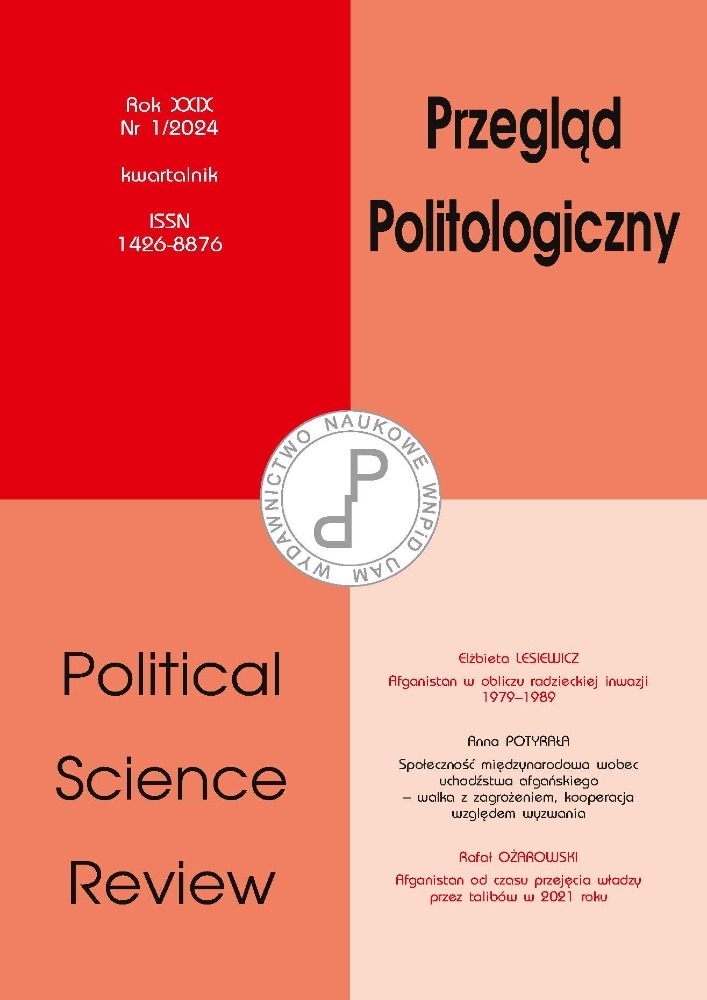Abstract
The aim of the article was to conduct an in-depth reflection on the attitude of the Afghan Taliban to the issue of cultural heritage and cultural goods, Many events, especially the spectacular destruction of Buddha statues in the Bamiyan Valley in 2001, have been interpreted in stereotypes based primarily on religious argumentation. The author tried to show the more complex genesis of the act of cultural barbarism, which was undoubtedly the destruction of the monuments from Bamiyan. The motivation of the fundamentalist interpretation of Islam is only one of the factors that led to the destruction of the dowries. Political and ethnic perspectives, issues of the politics of remembrance and many others should also be taken into account. To what extent was the act of destruction and what followed in the next quarter of a century merely a manifestation of barbaric fanaticism, and to what extent did it contain an element of pragmatism? The author tries to get closer to the answers to these non-obvious questions.
References
Ashebaby F. (2020), Cultural Heritage Protection in Islamic Tradition, „International Journal of Cultural Property”, vol. 27, 3, Cambridge. DOI: https://doi.org/10.1017/S0940739120000259
Bieczyński M. (2018), Destrukcja dzieł sztuki a prawo w ujęciu historycznym, „Studia Politologiczne”, vol. 50.
Bobin F. (2015), Disputes damage hopes of rebuilding Afghanistan’s Bamiyan Buddhas, https://www.theguardian.com/world/2015/jan/10/rebuild-bamiyan-buddhas-taliban-afghanistan, 1.03.2024.
Boggs E. (2016), Unesco takes on the taliban. The Fight to Save the Buddhas at Bamiyan, https://vtuhr.org/articles/10.21061/vtuhr.v5i1.39, 1.03.2024. DOI: https://doi.org/10.21061/vtuhr.v5i1.39
Centlivres P. (2012), The Death of the Buddhas of Bamiyan, https://www.mei.edu/publications/death-buddhas-bamiyan#edn2, 1.03.2024.
Cnn.com. (2002), Karzai pledges to rebuild Afghan Buddhas, https://edition.cnn.com/2002/WORLD/asiapcf/central/04/09/gen.karzai.bamiyan/index.html, 5.03.2024.
Crossette B. (2001), Taliban Explains Buddha Demolition, https://www.nytimes.com/2001/03/19/world/taliban-explains-buddha-demolition.html, 1.03.2024.
Cultural Landscape and Archaeological Remains of the Bamiyan Valley (2003), UNESCO, https://whc.unesco.org/uploads/nominations/208rev.pdf, 1.03.2024.
Destruction of Giant Buddhas Confirmed (2001), https://www.beliefnet.com/faiths/buddhism/2001/03/destruction-of-giant-buddhas-confirmed.aspx, 1.03.2024.
Franzioni F., Lenzerini F. (2003), The Destruction of the Buddhas of Bamiyan and International Law, w: „European Journal of International Law”, vol. 14, nr 4. DOI: https://doi.org/10.1093/ejil/14.4.619
Harding L. (2001), How the Buddha got his wounds?, http://www.guardian.co.uk/Archive/Article/0%2C4273%2C4145138%2C00.html, 1.03.2024.
Huntington S. (1996), Zderzenie cywilizacji, Muza, Warszawa.
Japan offered to hide Bamiyan statues, but Taliban asked Japan to convert to Islam instead (2010), https://japantoday.com/category/national/japan-offered-to-hide-bamiyan-statues-but-taliban-asked-japan-to-convert-to-islam-instead, 1.03.2024.
Joselow G., Elbaum R. (2021), The Taliban destroyed Afghanistan’s ancient Buddha statues. Now they’re welcoming tourists, https://www.nbcnews.com/news/world/taliban-destroyed-afghanistans-ancient-buddhas-now-welcoming-tourists-rcna6307, 1.03.2024.
Konwencja o ochronie dóbr kulturalnych w razie konfliktu zbrojnego podpisana podczas Konferencji ONZ w Hadze 14 maja 1954, https://www.unesco.pl/fileadmin/user_upload/pdf/Haga.pdf, 1.03.2024.
Malinowski K. (1977), Międzynarodowy charakter ochrony zabytków, „Acta Universitatis Nicolai Copernici”, 6/77, Toruń.
Milligan A. (2008), Targeting CulturalProperty: The Role of International Law, „Journal of Public and International Affairs”, 19, Princeton.
Modi memorandi. Leksykon kultury pamięci (2014), Scholar, Warszawa.
Mosse G. (1972), Kryzys ideologii niemieckiej, Czytelnik, Warszawa.
Nabi A. (2022), Crossroad of Culture: A Contested Space of Culture and Cultural Terrorism – Bamiyan, Afghanistan, „International Journal of Arts and Social Science”, vol. 5/11,
O’Donnell L. (2022), The Taliban Take Aim at Buddhist Heritage, https://foreignpolicy.com/2022/06/07/taliban-target-buddhist-heritage-afghanistan/, 1.03.2024.
Ochrona dóbr kultury w sytuacjach kryzysowych i konfliktach zbrojnych. Wybór źródeł międzynarodowych (2022), red. K. Góralczyk, M. Lemiesz, Akademia Marynarki Wojennej, Gdynia.
Power M. (2004), Destruction and Rebuilding the Bamiyan Buddhas, https://slate.com/news-and-politics/2004/07/dispatch-from-afghanistan-rebuilding-the-bamiyan-buddhas.html, 1.03.2024.
Rediff Interview/Mullah Omar (2004), We are hunting Americans down like pigs, https://www.rediff.com/news/2004/apr/12inter.htm, 1.03.2024.
Rozmus D. (2015), Ortodoksyjne prawo religijne a ochrona światowego dziedzictwa kulturowego – zarys zagadnień, „Roczniki Administracji i Prawa”, nr 1, Warszawa.
Safeguarding the Cultural Heritage of Afghanistan (2015), UNESCO, Paris.
Sałaciński K. (2015), Dziedzictwo kultury w konfliktach zbrojnych – prawo, praktyka, nowe wyzwania, w: Ochrona dziedzictwa kultury w konfliktach zbrojnych w świetle prawa międzynarodowego i krajowego, red. E. Mikos Skuza, K. Sałaciński, Wojskowe Centrum Edukacji Obywatelskiej, Warszawa.
Semple M. (2011), Why the Buddhas of Bamian were destroyed, https://www.afghanistan-analysts.org/en/reports/context-culture/guest-blog-why-the-buddhas-of-bamian-were-destroyed/, 1.03.2024.
Stein G. J. (2015), The War-Ravaged Cultural Heritage of Afghanistan, „Near Eastern Archeology”, vol. 78/3. DOI: https://doi.org/10.5615/neareastarch.78.3.0187
Szmygin B. (2018), Światowe Dziedzictwo Kultury UNESCO – charakterystyka, metodologia, zarządzanie, Politechnika Lubelska, Warszawa–Lublin.
Whose Culture? The Curation and Management of World Heritage, https://projects.iq.harvard.edu/whoseculture/bamiyan-buddhas, 1.03.2024.
World appeals to Taleban to stop destroying statues (2001), http://archives.cnn.com/2001/WORLD/asiapcf/central/03/03/afghan.buddhas.03/index.html, 1.03.2024.
License
Copyright (c) 2024 Paweł Stachowiak

This work is licensed under a Creative Commons Attribution-ShareAlike 4.0 International License.

